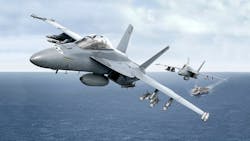PATUXENT RIVER NAS, Md. – Aircraft designers at the Boeing Co. will build 17 new single- and tandem-seat F/A-18 Super Hornet jet fighter bombers under terms of a nearly $1.4 billion order announced on Tuesday.
Officials of the Naval Air Systems Command at Patuxent River Naval Air Station, Md. are asking the Boeing Defense, Space & Security segment in St. Louis to build 10 F/A-18F Lot 46 aircraft; two F/A-18F; and five F/A-18E Lot 47 aircraft.
This order also provides for phase one of the F/A-18E/F and EA-18G technical data package including the operation, maintenance, installation and training data in support of F/A-18 and EA-18G sustainment.
The F/A-18E single-seat and F/A-18F tandem-seat variants are larger and more advanced versions of the F/A-18C and D Hornet jet fighter-bombers.
Related: EFW to provide replacement avionics displays for F/A-18 E/F jets in $19.8 million contract
The twin-engine carrier-capable multirole fighter and light-attack F/A-18E/F combat jets are based on the McDonnell Douglas F/A-18 Hornet, which entered U.S. Navy squadrons in 1983, but are larger and more advanced derivatives. The F/A-18E/F has a larger wing and a longer fuselage to carry more fuel and more powerful engines.
The newest versions of the F/A-18 first flew in 1995, and entered Navy service in 1999. These aircraft replaced variants of the Navy's F-14 Tomcat jet fighters, A-7 Corsair II light-attack bombers, A-6 Intruder medium-attack bombers, and S-3 Viking carrier-based maritime patrol jets.
The Super Hornet has an internal 20-millimeter M61 rotary cannon and can carry air-to-air missiles and air-to-surface weapons. The planes can carry additional fuel in as many as five external fuel tanks. These jets also can function as airborne tankers with external air refueling systems.
The Super Hornet aircraft have improved active electronically scanned array (AESA) radar, large cockpit displays, the joint helmet mounted cuing system, and several other avionics enhancements.
Related: Article headline goes here
The aircraft has the Raytheon AN/APG-79 AESA radar for search, track, and attack, as well as the Raytheon AN/ASQ-228 Advanced Targeting Forward Looking Infrared (ATFLIR) electro-optical sensors and laser designator pods.
The Super Hornet has a modern mission computer, and infrared search and track (IRST) electro-optical passive surveillance and targeting system.
The F/A-18E/F avionics suite features an up-front touchscreen control display; a large multipurpose color liquid-crystal display; and a fuel display. It has a quadruplex digital fly-by-wire system, and digital flight-control system that detects and corrects for battle damage.
The Super Hornet's communications equipment includes AN/ARC-210 VHF/UHF radio and a MIDS-JTRS low volume terminal for HAVE QUICK, SINCGARS, and Link 16 RF communications and tactical networking. Its defensive avionics have the AN/ALR-67(V)3 radar warning receiver, the AN/ALE-47 countermeasures dispenser, the AN/ALE-55 towed decoy, and the AN/ALQ-214 integrated defensive countermeasures (IDECM) system with internally mounted threat receivers and optional self-protection jammers.
The Super Hornet's Shared Reconnaissance Pod (SHARP) is a high-resolution, digital tactical aerial reconnaissance system with advanced day, nighttime, and all-weather capability.
On this order Boeing will do the work in Hazelwood, Mo.; El Segundo, Calif.; Bloomington, Maine; Quebec City; Ridley Park, Pa.; Vandalia, Ohio; and other locations inside and outside of the U.S., and should be finished by April 2027.
For more information contact Boeing Defense, Space & Security online at www.boeing.com/company/about-bds, or Naval Air Systems Command at www.navair.navy.mil.



